There are many manga and anime about school delinquents, or that feature delinquent characters. For reference, an article about them.
In Japanese
There are several ways to say "delinquent" in Japanese. The most general term would be:
- furyou
不良
"Not good." (literally.)
Delinquent. - furyou shounen
不良少年
Delinquent boy.- furyou koui shounen
不良行為少年
"Not-good acts boy." (literally.)
A boy that does bad things, including smoking, drinking, staying outside until late, getting into fights, stealing, etc.
- furyou koui shounen
- furyou shoujo
不良少女
Delinquent girl.
Nowadays, this term is synonymous with:
- yankii
ヤンキー
Yankee. (literally.)
The word yankee refers to someone from the United States. In Japan, after the second world war, Japanese delinquents started copying the style of American soldiers, such as the pompadour hairstyle, loose pants, and blond hair, and this style became known as yankee in Japanese.(oshiete.goo.ne.jp)
- In Yu Yu Hakusho 幽☆遊☆白書, Urameshi Yusuke 浦飯幽助 wears loose pants and pompadour.
- In JoJo's Bizarre Adventure: Diamond is Unbreakable, Higashikata Josuke 東方仗助 wears loose pants and a pompadour, too.
The school delinquents you typically see in anime, that try to act tough, pick fights, and say stuff like:
- namete-n-no ka, kora?!
ナメてんのか、コラ?!
Are you mocking me, huh?!- ~te-n-no - contraction of ~te-iru no ka ~ているのか.
—are generally based on a boom of delinquent-related series from the 80's, when such delinquents were called:
- tsuppari
ツッパリ
Rebel.
- tsupparu
突っ張る
For something to protrude (tsuku 突く) and swell (haru 張る, ~paru is handakuonka 半濁音化), e.g. muscles when flexing.
To resist someone. To assert yourself. To stick to your guns.
- tsupparu
Another term worth noting is:
- chinpira
チンピラ
Hoodlum. Punk.- A small-time yakuza member, who goes around extorting random people, picking fights, etc. In the sense that a higher member of an organized crime syndicate wouldn't waste their time doing this stuff, only a chinpira would do this.
Banchou 番長
A banchou 番長 is the "boss," i.e., the gang leader of a delinquents' group, or the delinquents of a school.
- ~chou
~長
Leader. - ban
番
Post. Typically a guard post.(detail.chiebukuro.yahoo.co.jp)- banken
番犬
Guard dog. Watchdog.
- banken
- ban wo haru
番を張る
To be the leader of a gang.
- miharu
見張る
To stand watch. To lookout.
- miharu
- bankaku
番格
The "ban role," in the sense of who has the role of ban, i.e. of leader in a school.
Obviously, the banchou ought to be the strongest delinquent around, except that this guy is typically not the protagonist, so he'll get defeated eventually.
In rare cases, the label is applied sarcastically.
- In Minami-ke みなみけ, Minami Haruka 南春香 is the legendary banchou of her high school, despite not even being a delinquent.
Uraban 裏番
The uraban 裏番 is the "shadow boss" of a gang. In other words, the guy who calls himself the boss, and who everybody thinks is the boss, is actually a figurehead, and the true boss you have to defeat to get the true ending is someone else.
- omote
表
Front side. Surface.
Out in the light. - ura
裏
Back side. Underneath.
Hidden in the shadow.
Naturally, the uraban is going to be stronger than the banchou, so sometimes the banchou loses to a random guy in the school who may not even be a delinquent, and everybody assumes that guy is the uraban, i.e. that guys is the real boss of the school, and the banchou is just a figurehead.
Shiten'nou 四天王
The shiten'nou 四天王 are the "four heavenly kings," or "four devas," from Buddhism, who are said to watch over each cardinal direction (North, West, South, East).
The ou 王, "king," morpheme becomes ~nou in this word due to renjou 連声.
This label is often applied to a group of four characters that excel in something, like the four kings who are the strongest delinquents of a school, or the four kings.who are the strongest banchou of a city, etc.
- Context: the four devas of a certain school.
Female
There are two types of female delinquents in anime: the gyaru ギャル and the sukeban スケバン.
- Context: gyaru Mai-nyun まいにゅん unleashes her ultimate technique on sukeban Kamio Yui 神緒ゆい.
- yankii gyaru ougi
ヤンキーギャル奥義
Delinquent gal secret technique. - maji-manji-gatame
マジ卍固め
Serious swastika hold.- maji-manji
マジ卍
(a slang vaguely meaning something is intense.) - manji-gatame
卍固め
Swastika hold. (literally.)
Octopus hold. (English name for the same wrestling technique.) - This is the skill that Mai-nyun acquired after arduous training as a gyaru. Don't ask me what in the world that training was. I have absolutely no idea.
- Unlike the normal manji-gatame, which targets only a few vital spots, the maji-manji-gatame targets 109 vital spots, according to the manga.
- This number, 109, pronounced maru-kyuu, literally "circle nine," with "circle" being a way to say "zero" when spelling out numbers, is in reference to the iconic department store in Shibuya 渋谷, the Ichi-maru-kyuu 109, which is a tower with a red 109 written on it.
- maji-manji
The term gyaru refers to a fashion style, or rather, to several fashion styles, including ko-gyaru コギャル, "school gyaru," with loose socks, kuro-gyaru 黒ギャル, "black gyaru," with dark skin, etc. The term also refers to someone who wears such style.
A gyaru character is stereotypically gaudy and promiscuous, and may hang with delinquents, but is typically not the fighting type.
The gyaru are delinquents since they tend to do "not good" stuff, like drinking and smoking while underage, and, in particular, engaging in a form of prostitution known as enjo-kousai 援助交際.
Anime: Saiki Kusuo no Ψ-nan 2 斉木楠雄のΨ難 2 (Episode 8)
- Context: a gyaru with ganguro ガングロ, dark skin acquired through makeup or tanning.
The term sukeban 助番 means literally "female banchou," but is used toward female delinquents regardless of whether they're a banchou or not.
A sukeban is a fighting sort of female delinquent. They're typically strong enough to beat male delinquents in a fight.
- otoko-masari
男勝り
Man-besting.- masaru
勝る
To win against. To best.
- masaru
The term had its boom in the 80's, so sukeban characters are often based on how high school girls looked at the time, with a dark sailor uniform and long skirt.
Anime: Kirarin☆Revolution, きらりん☆レボリューション (Episode 47)
- Context: a sukeban often carries a wooden or bamboo sword used in kendō 剣道 practice.
Tropes
For reference, some delinquent related tropes you may see in anime.
Not Seen Nowadays
Most delinquents you see in anime nowadays aren't based on delinquents of modern Japan, but on delinquents seen in manga, which parody other manga about delinquents, which were released over 40 years ago.
As such, sometimes a character will point out how nobody acts like that anymore.
Some series try to avoid the above by having adult characters that used to be delinquents, but even those are would be dated by now.
- In GTO, published in 1996, Onizuka Eikichi 鬼塚英吉 is a teacher who used to be the protagonist of a completely different series about delinquents: Shonan Jun'ai-gumi! 湘南純愛組!, published in 1990.
Appearance
As many other types of characters, delinquents typically have a very stereotypical, mean-looking appearance in fiction.
Pompadour
Many delinquent characters have a pompadour hairstyle. In Japanese, this is normally called:
- riizento
リーゼント
"Regent." (literally.)
A more accurate translation would be its katakanization:
- pompadooru
ポンパドール
Pompadour.
To elaborate: the term "regent" commonly refers to the pompadour nowadays, but originally it referred to a different hairstyle.(dic.pixiv.net)
The reason why so many delinquents have a pompadour is simply due to delinquents copying the fashion style of American soldiers, i.e. the yankii style.
Blond Hair
Delinquents often have blond hair, which isn't their natural hair color. Again, this is an yankii fashion thing, copied from American soldiers.
- kinpatsu
金髪
Golden hair. Blond hair.- ~patsu - hatsu with rendaku 連濁.
In general, Japanese people don't have natural blond hair, so by dying one's hair blond, it stands out.
Japanese schools tend to have strict uniform rules, which forbid, in particular, dying one's hair.
Anime: Kyou kara Ore wa!! 今日から俺は!! (Episode 1)
- Context:
- kyou kara ore wa tsuppari da!
今日から俺は突っ張りだ!
Starting today I'm a delinquent! (in the sense of a tough guy.)- tsupparu
突っ張る
To act tough. To stick to one's guns.
- tsupparu
- kyou kara ore wa tsuppari da!
- kinpatsu ni shite paama wo kakete kudasai!
金髪にしてパーマをかけてください!
Make [it] blonde and put a perm on [it]!- X wo Y ni suru
〇〇を〇〇にする
To make X Y.
- X wo Y ni suru
- hontou ni ii no? koukousei desho
本当にいいの?高校でしょ
Is [it] really fine? [You] are a high school student, [aren't you]? - ii-n-desu. gaikoku niwa takusan imasu kara
いいんです。外国にはたくさんいますから
If found with hair dyed blonde, a student may be told to dye it black again. In anime with natural hair colors this may happen, but some anime just have all sorts of natural hair colors, like blue and green, so having blond hair barely matters.
Warning: in anime, sometimes a character has natural pink hair. Japanese people aren't born with pink hair.
In similar fashion (pun intended), a gyaru may turn her face black with makeup (ganguro) in order for the colored makeup and strands to stand out more.
Anime: Nyan Koi! にゃんこい! (Episode 2, Rotated)
Small Irises
Delinquents often have small irises.
- sanpakugan
三白眼
Three-white-eye. Refers to an iris small enough to be surrounded by sclera on three sides. - shihakugan
四白眼
Four-white-eye. An even smaller iris, surrounded by sclera on all four sides. Sometimes drawn on spooked characters.
In general, large irises look cute, and small ones look threatening. Although you can't really change the size of your irises yourself like you could with your hair, authors in general draw mean-looking character with their irises small.
Anime: Handa-kun はんだくん (Episode 3)
No Eyebrows
Delinquents sometimes have their eyebrows shaved to look more threatening.
- Context: Kitano Seiichirou 北野誠一郎 enters the classroom and sees his seat is currently occupied by Takehisa Yuji 竹久優二, who is a delinquent.
- komatta naa doushiyou
こまったなあ どうしよう
[Oh no]. [What should I do]?- komaru
困る
To trouble. Often used in reference to inconveniences and problems. In this case, someone being seated in his seat "troubled" Seiichirou.
- komaru
- nante ieba kado ga tatanai darou
なんていえばカドがたたないだろう
What do [I] say [to solve this amicably], [I wonder]?- kado ga tatsu
角が立つ
(For) corners to stand. (literally.)
When an action makes a relationship worse. In this case, asking Yuji to move to another seat might make him mad.
- kado ga tatsu
- kuso... bibitte tamaru ka
くそ・・・びびってたまるか
[Shit...there's no way I'll chicken out!]- Yuji thinks Seiichirou is challenging him into a stare down.
- bibiru
びびる
To be afraid. To chicken out. To drop out of a challenge. - tamaru
堪る
To endure. (literally.)
Often used in the patterns tamaru ka and tamaru mono ka to say they won't endure something, that something isn't acceptable.
- gan-tsuke nara makenee zo
ガンつけなら負けねえぞ
If it's a stare down, [I] won't lose! - nanto ieba
なんといえば
What should [I] say. - ku... makeneeee'
く・・・負けねーーーっ
Gh.... [I] won't lose! - makete tamaru ka
負けてたまるか
[There's no way I'll lose]!! - u~~~~~~n
う~~~ん
Hmmmm~~~~~~
Not everyone who shaves their eyebrows is a delinquent, however.
Anime: Hyouge Mono, へうげもの (Episode 2, Stitch)
- Context: Osen sits in seiza 正座 position.
- hikimayu
引眉
The cosmetic practice of removing one's eyebrows, done from the Nara period to the Edo period (710–1868).
Masks
Some delinquents wear masks to look more threatening. I'm talking about simple, white masks, the ones for medical use.
Not oni 鬼 masks, or fox masks, or V for Vendetta masks, or Tokyo Ghoul masks, or wearing a sock like a mask the way a thief would. Just normal, white masks, or sometimes black, but simple masks nonetheless.
Mistaken for Delinquent
Sometimes, a character ends up being mistaken for a delinquent due to his appearance.
- In Angel Densetsu エンジェル伝説, Kitano Seiichirou 北野誠一郎 has a very devilish appearance, featuring very small irises and no eyebrows.
Even if we aren't talking about delinquents, specifically, many series are about a whole school assuming a character is way cooler than they actually are.
- Handa-kun はんだくん is the ultimate example of this trope.
- In Mairimashita! Iruma-kun 魔入りました!入間くん, Suzuki Iruma 鈴木入間, who is human, is assumed to be the strongest demon in school due to a series of misunderstandings.
- Iruma 入間 is a wordplay on ningen 人間, "human."
Naturally Blond
Although Japanese people generally don't have blond hair, it's not impossible to find someone who is both native Japanese and blond. After all, if you have a child with someone who is blond, there's a chance the child will be blond, too.
Characters who are half-Japanese, half-something else, can end up getting mistaken for a delinquent that dyes his hair.
- In Haganai はがない, Hasegawa Kodaka 羽瀬川小鷹 is naturally blond, and as such everybody assumes he's a delinquent.
- Context: one of the four heavenly kings of playing, who appears to be a gyaru with manba マンバ makeup, but swears that's her natural hair color and that butterfly isn't an accessory but actually alive and just landed on her head.
Respect The Hierarchy
Delinquents often obey the senpai-kouhai 先輩後輩 system, given that seniors demand respect from juniors, by which I mean it's closer to first-year students getting bullied by third-year students a lot.
- tsukai-pashiri
使い走り
Errand boy.- Seniors may make juniors go buy lunch for them and other petty errands like that.
Members of a gang may use keigo 敬語, "respectful language," when speaking to their seniors and to the boss of a gang.
Since a school gang isn't a business, you may see some peculiar usage, like:
- Using the masculine first person pronoun ore 俺 with keigo, which is avoided when speaking formally.
- Ending sentences with ~ssu ~っす instead of desu です or ~masu ~ます.
- ore ssu ka?
俺っすか?
Me? - ore desu ka?
俺ですか?
- ore ssu ka?
Escalation
In series in which the protagonist goes around fighting delinquents, regardless of whether the protagonist is a delinquent or not, each enemy he defeats spreads his fame around, and with fame comes stronger foes, which when defeat give him more fame, and more foes.
Typically, it goes like this:
- Enter high school as a freshman.
- Fight a delinquent in school.
- Fight the delinquent's senpai 先輩, probably a third-year student.
- Fight the banchou.
- Fight the uraban.
- Fight another school.
- Fight the four heavenly kings.
Yakuza ヤクザ
The yakuza ヤクザ, also spelled 893, are the Japanese mafia. Although they're similar to delinquents in that the yakuza does illegal stuff and has groups with bosses, it's otherwise completely different because one is a bunch of kids, while the other is organized crime.
Typically, delinquents will not fight the yakuza. Picking fights with delinquents gets you in the hospital, but picking fights with the yakuza gets you in the cemetery. Delinquents fight with sticks, the yakuza fights with bullets.
That said, there are several series in which the heir, the next head of a certain yakuza group happens to be in high school, and happens to be a delinquent, possibly part of the local school gang.
Anime: Gokushufudou 極主夫道 (Episode 1)
- Large tattoos, specially on back, is a hint a character is a yakuza member.
Gokudou 極道
A related term is gokudou 極道, "extreme path," which originates in Buddhism, but is used by the yakuza to refer to their own way of life.
Series like Gokushufudou 極主夫道 and Gokusen ごくせん, which feature protagonists related to the yakuza, have this goku morpheme in their names.
Biker Gangs
Delinquents are often part of a "biker gang," bousouzoku 暴走族, riding together and making noise on the streets.
Motorbikes are more affordable than cars, so for delinquents in school they're far easier to get. They're also closer to a bicycle than to a car, so it's not hard to learn to drive them, specially considering these delinquents don't actually have a license to drive.
- baiku
バイク
Motorbike. (doesn't include bicycles.)- jitensha
自転車
Bicycle.
- jitensha
The term redhiisu レディース, "ladies," applies specifically to female biker gangs.
Left: Tanimura Chiaki 谷村千秋
Right: Oomori Nene 大森寧々
Anime: Beelzebub, べるぜバブ (Episode 8, Stitch)
- Context: members of the ladies Red Tail, 烈怒帝瑠.
- This spelling is an ateji 当て字: re'-do-tei-ru 烈怒帝瑠.
- sarashi
さらし
The term for the cloth wrapped around her chest.
Left: Kuurubiyuutei Gankyou 空琉美遊亭丸京
Center: Buratei Marii 蕪羅亭魔梨威
Right: Bouhatei Tetora 防波亭手寅
Rightmost: Haroukitei Kigurumi 波浪浮亭木胡桃
Anime: Joshiraku じょしらく (Episode 7)
- Context: a group of girls pretend to be delinquents.
- tokkou-fuku
特攻服
Special attack clothes. The long white jacket worn by gang members, typically with something written on the back.
Squatting
Delinquent characters are often see squatting around, such that there's event a term for this delinquent squat: yankii-zuwari ヤンキー座り.
Manga: Rokudenashi Blues, ろくでなしBLUES (Volume 25, Chapter 仏の顔も・・・)
Smoking
Delinquents are often found smoking around, and perhaps event drinking alcohol, two substances whose sale is forbidden to minors, which, in this case, means anyone younger than 20 years old.
This means that even a character in the last year of high school is legally not allowed to smoke. Not that that would stop delinquents, anyway.
Series broadcast on TV tend to suffer censorship, so it's likely that scenes delinquents smoking will be removed.
- The series Kyou kara Ore wa!! above is OVA, it didn't air on TV, being sold directly as video, so it wasn't subject to TV censorship.
- The series Sakigake!! Cromartie Koukou, 魁!!クロマティ高校, which is a parody of Sakigake!! Otokojuku 魁!!男塾, parodied the censorship in its anime adaptation, replacing cigars with bizarre reverse-lollipop-looking sticks with a bouncing slime on the tip.
Ex-Delinquents
Some series aren't about delinquents, but about ex-delinquents instead. Characters that look like completely average people, except they have a dark past: they were members of a gang and fought every day like there was no tomorrow.
- moto-yan
元ヤン - moto yankii
元ヤンキー
Former delinquent.
Although this sounds like the plot of some serious drama series about readjusting to society, this plot is mostly found in comedy, where the character has a hard time forgetting his old habits and keeps saying and doing stuff typical of a delinquent.
- In Saiki, Kuboyasu Aren used to be a delinquent, but then he stopped.
- In Zombieland Saga, Nikaidou Saki used to be a delinquent, but then she became a zombie.
- in Gokushufudou, Tatsu たつ used to be a yakuza member, but then he married.
Ex-delinquent characters are often far stronger than the average delinquent. They won't back down if someone picks a fight with them.
Delinquent School
Some series have as theme a school or class that's entirely made out of delinquents, or far-for-model students. These include:
- In Sakigake!! Cromartie Koukou, 魁!!クロマティ高校, the protagonist, who isn't a delinquent, transfers to a delinquent school. If you want to know why would he do something like that, read the manga.
- It's a parody of Sakigake!! Otokojuku 魁!!男塾, which similarly features a school full of delinquents.
- In Gokusen ごくせん, the protagonist teaches a school full of delinquents.
- In Beelzebub べるぜバブ, the school looks like a war zone, with pretty much every last student being a delinquent, including the protagonist.
- In Kyou kara Ore wa 今日から俺は, the protagonists decide to become delinquents, and unfortunately for them the school they enroll is already full of delinquents.
- In Ansatsu Kyoushitsu 暗殺教室, most characters are part of the class 3-E, which only has delinquents and students forsaken by the school.
Exceptionally:
- In Baka to Test to Shoukanjuu バカとテストと召喚獣, most characters are part of the class 2-F, which is populated by idiots with awful grades, not delinquents, although it does have some sort of murderous cult in it.
Baseball Bat
A baseball bat is a weapon commonly used by delinquents.
- In One Punch Man, Wanpan-man ワンパンマン, the hero "Metal Bat," Kinzoku Batto 金属バット, is a delinquent who uses a bat as weapon. The bat is made out of metal.
Anime: Saiki Kusuo no Psi-Nan, 斉木楠雄のΨ難 (Episode 17)
- Context: an ex-delinquent plays baseball.
Puppy in The Rain
Sometimes, a delinquent or another mean-looking character will find an abandoned puppy in the rain, or something like that, and will take care of it, showing that the character isn't all evil, he actually has a good heart.
- Context: Gintoki explains the "gap rule," gyappu ruuru ギャップルール.
- {{fudan wa riizento de tsuppate-iru} yatsu ga
tamaa ni {ii} koto shitari suru} to
monosugooku koukando ga agaru
普段はリーゼントでツッパっている奴がたまーにいい事したりするとものすごーく好感度が上がる
If {{a guy [who] {normally [wears] a pompadour and acts tough}
does something {good} once in a while}
[his] popularity rises by a lot.- koukando
好感度
Level of favorability. Popularity.
How much people like someone. - i.e. when a bad guy does something good, people's opinion of him suddenly changes from bad to good.
- koukando
!?
Sometimes, you may see an interrobang (!?) appear over a delinquent's head in an anime, like this:
Anime: Zombieland Saga, ゾンビランドサガ (Episode 9)
- kantan-fy gimon-fu
感嘆符疑問符
Exclamation mark, interrogation mark.
!?
Interrobang.
Nowadays, this pretty much only happens in parodies.
- Context: Saiki Kusuo 斉木楠雄 uses his mind-reading ability to hear what Kaidou Shun 海藤瞬 is thinking, specifically, he's listing some strange stuff that he saw Kuboyasu Aren 窪谷須亜連 doing.
- sore ni {{tokidoki yatsu no atama no ue ni {"!?" toiu} {hen na} moji ga arawareru} no mo okashii} to omotte-ita...
それに時々奴の頭の上に「!?」という変な文字が現れるのもおかしいと思っていた・・・
Besides that, [I] also thought {[it] was weird that {sometimes a {strange} {"?!"} character appears above [his] head}}. - sore φ mieru no?
それ見えるの?
That is visible? (literally.)
You can see that?
Even though in parodies (!?) the interrobang shows up all the time!? It still pales in comparison (!?) to the absolutely ridiculous (!?) volume of interrobanging you!? Could see in the original 90's delinquents manga!? It showed up almost every single panel!?
- Context: this is one chapter. And it isn't even all the interrobangs of this one chapter.
- No, I didn't edit this. It's really, actually, in fact plastered with interrobangs all over. I just made them red.
- And it isn't just this chapter. Every single chapter is like this.
- The last one isn't an interrobang, though, that's three exclamation marks!!!
卍
The "swastika," manji 卍, is normally a symbol associated with Buddhism in Japan, but it's sometimes used by delinquent characters.
The reason for this is primarily that some gangs of the past used the swastika as their symbol, so the swastika got associated with being "dangerous," yabai ヤバい, in the sense of "don't mess with us."
- Context: a biker gang.
There are also examples of this usage in manga and anime.
- Context: the boss arrives, characters react to his arrival.
- Note: one of the characters is all beaten up, panting haa haa ハァハァ and bleeding because he was forced by the gang to participate in fighting matches involving gambling, which the gang profits from.
- muteki no Maikii
無敵の“マイキー”
The peerless Mikey.- muteki
無敵
Enemy-less. Without enemy.
Peerless.
Invincible.
- muteki
- Tooman no bosu da!!!
東卍(トーマン)のボスだ!!!
The boss of Touman!- See: long vowel, gikun 義訓.
- koitsu ga
こいつが
This guy [is]... - koitsu ga Toukyou Manji-kai no toppu
こいつが東京卍會のトップ
This guy is the boss of Toukyou Manji-kai.- toppu
トップ
Top.
Boss. (who's at top of an organization.) - ~kai
~會
Association. - So Toukyou Manji-kai is literally Tokyo Swastika Association.
- toppu
- Sano Manjirou!!?
佐野万次郎!!?
(character name.)- Note: the jirou 次郎 name suffix normally means second born son, and implies he might have an older brother called Sano Man'ichirou 佐野万一郎 or something like that.
Nowadays, the swastika is often a slang that's about as meaningful as "pog," specially on the internet.
References
- 不良とヤンキーの違いって何ですか。 - oshiete.goo.ne.jp, accessed 2021-03-29.
- 『番』て何 - detail.chiebukuro.yahoo.co.jp, accessed 2021-04-06.
- リーゼント - dic.pixiv.net, accessed 2021-04-10.

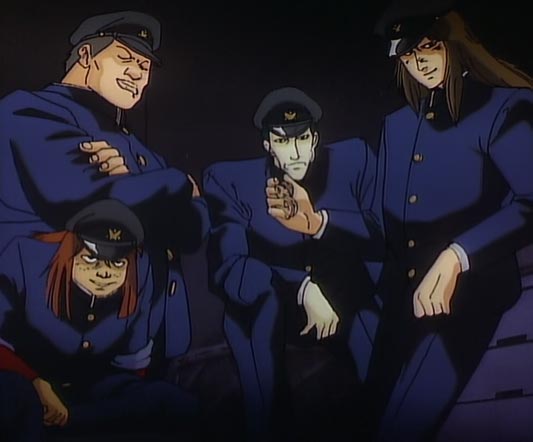

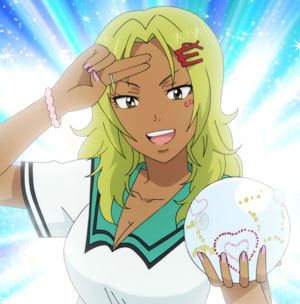
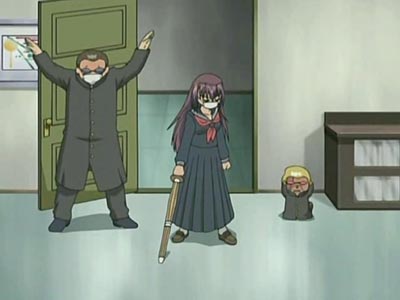
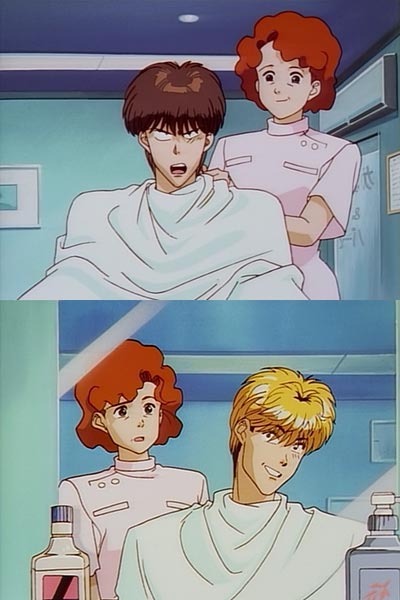
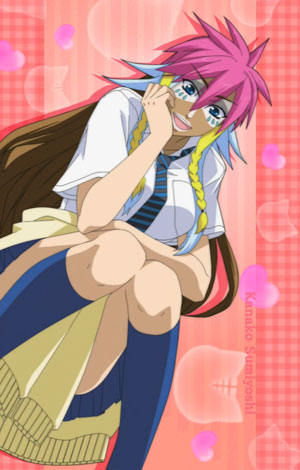
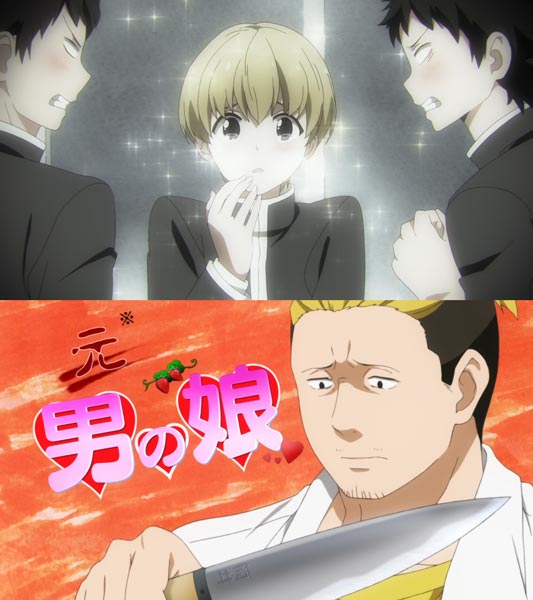

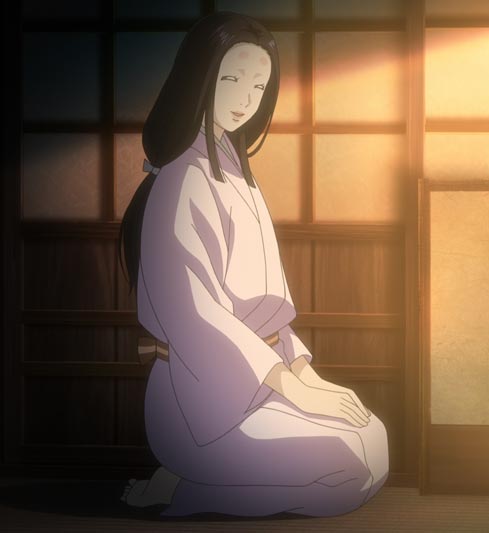
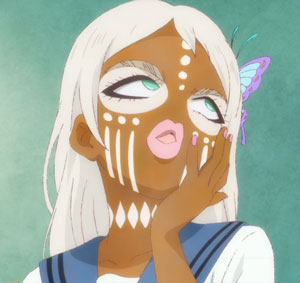
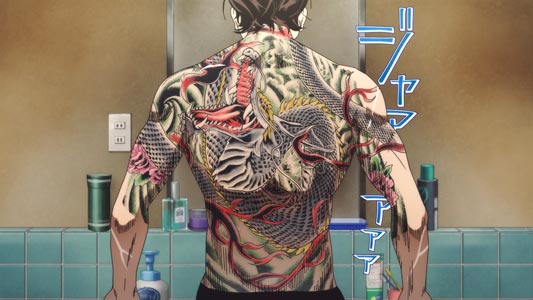

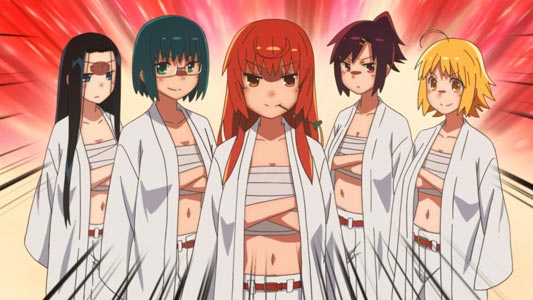
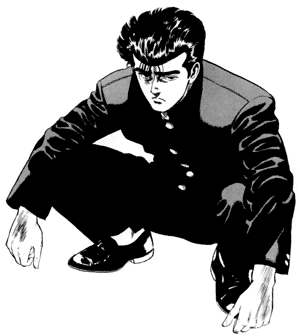

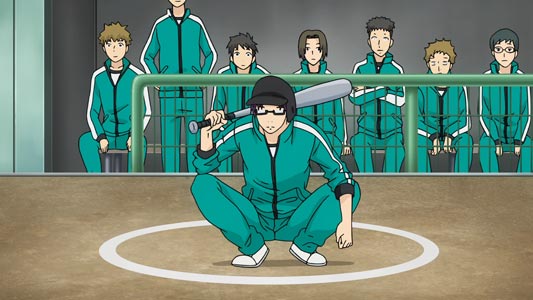



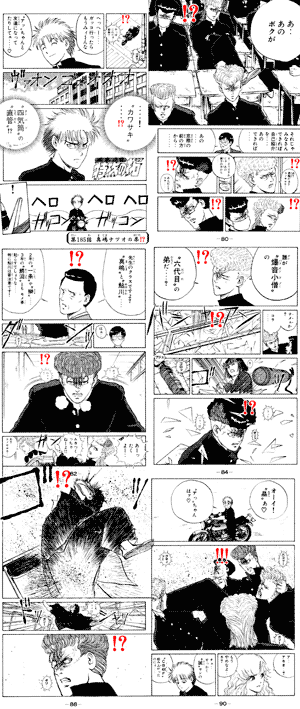
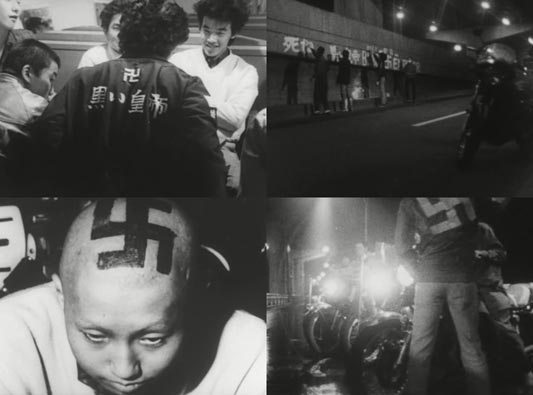
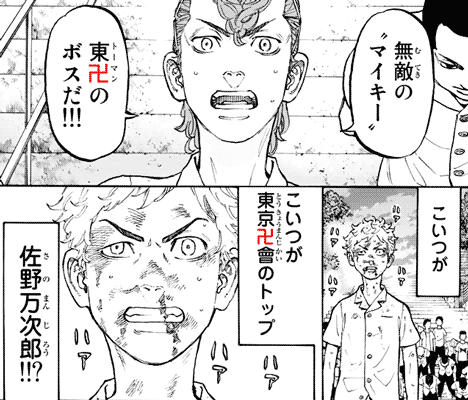
No comments: